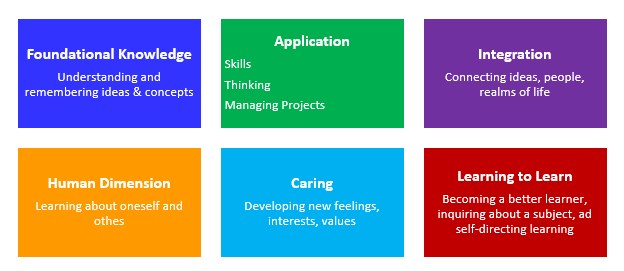Fink’s Taxonomy Verbs
About Fink’s Taxonomy
In his book “Creating Significant Learning Experiences,” Dee Fink defined learning in terms of change. He believes in order for learning to occur, there has to be some kind of lasting change that is important in terms of the learner’s life. Essentially, if there is no change, there is no learning.
Fink’s Taxonomy Six Aspects of Learning
Fink’s taxonomy consists of six types of significant learning with a number of sub-categories.
Fink’s Taxonomy – Six Aspects of Learning:
- Foundational Knowledge – Understanding and remembering information and ideas
- Application – Developing critical, creative, or practical thinking skills
- Integration – Making connecting between information, ideas, perspectives, people, or realms of life
- Human Dimension – Learning about oneself or others
- Caring – Developing new feelings, interests, or values
- Learning How to Learn – Becoming a better student, inquiring about a subject, becoming self-directing learners
Creating Learning Outcomes
When designing learning courses/sessions, you should include these six significant types of learning as important learning outcomes for a course. And when writing outcomes for a course, you should include specific verbs for the different types of learning you want to achieve.
Fink’s Taxonomy Verbs for the aspects of Learning
There are specific verbs associated with different types of learning relating to the six aspects of learning from Fink’s Taxonomy. By creating learning outcomes using these verbs, you indicate explicitly what the learner must do in order to demonstrate learning at that level.
Fink’s Taxonomy Verbs for Learning Outcomes
Learning outcomes should be formulated with verbs that are specific to clearly indicate what learners will do. Below is a list of verbs linked to specific learning behaviors Fink addresses. These verbs can be used in writing learning objectives or outcomes.
Foundational Knowledge
Associate, Compare, Contrast, Describe, Define, Explain, Give example, Identify, Illustrate, Indicate, List, Name, Paraphrase, Recite, Recognize, Remember, Repeat, Restate, Tell
Application
Analyze, Assess, Critique, Calculate, Create, Coordinate, Demonstrate, Draw, Employ, Estimate, Give example, Illustrate, Imagine, Interpret, Judge, Locate, Make decisions, Manage, Measure, Operate, Perform, Prescribe, Record, Solve, Use
Integration
Associate, Blend, Combine, Compare, Connect, Contrast, Correlate, Differentiate, Integrate, Intermix, Join, Link, Relate, Synthesize, Unite
Human Dimensions
Acquire, Advise, Advocate, Behave, Communicate, Collaborate, Cooperate, Empathize, Express, Feel, Help, Influence, Initiate, Inspire, Interact, Involve, Lead, Mediate, Motivate, Negotiate, Nurture, Promote, Protect, Reconcile, Resolve, Reflect, Respect, Respond, Share, Support, Unite
Caring
Commit to, Decide to, Demonstrate, Develop, Discover, Explore, Express, Identify, Interpret, Pledge, Recognize, Value, Reflect, Renew, Revitalize, Share, State, Value
Learning to Learn
Analyze, Construct knowledge, Critique, Create a plan, Describe how to, Develop a learning plan, Identify resources, Identify your learning style, Identify needs, Inquire, Formulate Frame questions, Generalize knowledge, Predict performance, Reflect, Research, Self-assess. Self-regulate, Self-monitor, Set goals, Take responsibility, Transfer knowledge
Related Links
Taxonomy of Significant Learning

